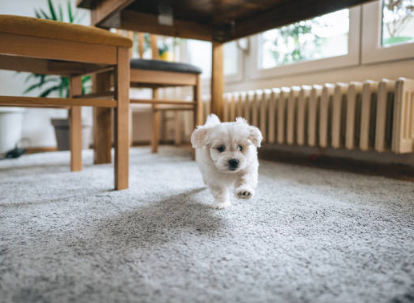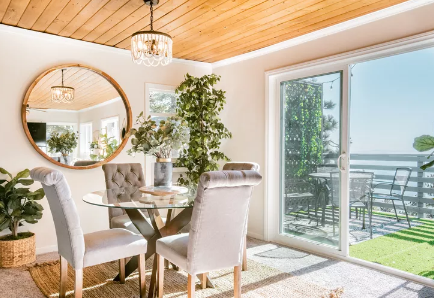
10 Reasons to Try Moroccan Rugs
November 28, 2023
How to Choose the Right Rug Size for Your Living Room
December 9, 2023Buying a rug is not something that most people do very often. In fact, some people may only buy rugs a few times in their lifetime. Because of this, it is easy for consumers to get confused about the carpet buying process and end up buying a carpet that does not meet their needs.
When you’re shopping for a rug, it’s important to avoid these common mistakes.

Obsessed with Weight
This is probably the first thing we remind people not to do when buying a rug. Don’t think that a carpet with a higher face weight is better than a carpet with a lower face weight. This is an easy mistake to make, because we can easily grasp the concept of assigning a numerical value to something to indicate the mass, in other words, we “get” the idea that the bigger the number (weight), the better. However, when it comes to carpets, there are many other factors that come into play when determining the overall quality. Unfortunately, salespeople are often either too ignorant or too aloof to properly explain this to customers. It’s easier to tell someone about 50 ounces. Carpets are better than 40 ounces. The carpet than it explains all the other considerations: twist, density, etc.
Save on the Pads
This is pretty much the worst mistake you can make when buying a new rug. Trust us, we know how hard it is to prove spending extra money on something you can’t see. You may prefer to save up and spend your money on something you can sit down and look at – maybe buy a new lamp with the money you’ve saved on the mat. But most of the time, it’s what you can’t see that counts. For example, consider a car’s tires or mattress. Neither has any aesthetic value, but both are extremely important for your safety and comfort. The same goes for carpet underlays.
The underlay absorbs the impact of foot traffic, which reduces wear and tear on the carpet, which the carpet does not have to. A higher grade of underlay not only feels more comfortable to walk on, but it can also help your rug maintain a better appearance for a longer period of time compared to inferior mats.
We have to emphasize this: your rug is only as good as your mat. If you’re on a tight budget, we highly recommend spending a little less on carpets and a little more on mats. Low-quality carpets look better, feel and perform better when paired with high-grade underlayments.
Let’s Say the Carpets Are the Same Because They Look the Same
This warning is especially useful if you get quotes for different products from different retailers. As the saying goes, it’s important to make a like-for-like comparison! Just because two rugs look and feel the same doesn’t necessarily mean they perform the same.
So how do you compare different products? Make sure they’re made from the same fiber, the same style, the same quality. Also, carefully compare the manufacturer’s warranty on the carpet. If one rug has a 10-year warranty and another has a 20-year warranty, then you’re clearly not looking for a rug of the same quality.

Calculate Your Square Footage (Error)
We thought it would be a good idea to measure your size before heading out shopping. It will help you get a rough idea of the overall cost of your project so that you know which products you can actually consider to stay within budget. However, we highly recommend that you take a measurement and then hand it over to the salesperson.
Calculating carpet requirements is much more complicated than simply adding up the square feet of a room. There are plenty of other factors to consider, such as the width of the carpet roll and the orientation of the carpet pile, and simply multiplying your measurements will not usually give you accurate results. The salesperson will know how to account for these factors and should be able to provide you with an approximation of the total square footage requirements. But keep in mind that the salesperson’s quote depends on the information you provide: if you make a measurement mistake or miss important details like closets or railing posts (which add to labor costs), the true cost of the project won’t increase. Don’t make up your mind until a professional visits you.
Be Attracted to “Promotions”
We all love to bargain, so it’s easy to believe the promise of spending $99 to install an entire rug, or buying a rug and getting a free mat. But sadly, many of the deals are actually too good to be true. Most of the time, the cost of these “free” or “discounted” products and services is simply established elsewhere.
For example, consider a situation where Company A offers a $99 whole-house installation, while Company B charges $0.50 per square foot for installation. If you’re installing a 500-square-foot rug, Company B’s installation fee will be $250. On the surface, it may seem like working with Company A will save you $151. However, what you may not realize is that Company A will charge you for every peg, every staple, every inch of seam tape, etc. These are known as hidden fees and can significantly increase the overall price. These hidden fees are designed to compensate for the cost of a “free” installation.
To avoid getting bogged down in promotional wording, be sure to get the full “all-inclusive” price and make sure you know what’s included in that price and what might be extra.

“Unprofessionally” Installing Carpets
If you have a basic square room with no complicated places to lay a rug, then you can install the rug yourself or ask your “handy” friend to install the rug for you. However, other than that, you’d better install the carpet professionally. Carpet installers are called professionals for a reason. This is because they install carpets every day and have all the special tools and experience they need to install them properly.
Yes, carpet installation can be expensive, especially if there are a lot of obstacles and joints (stairs, railing posts, etc.). But a poorly installed carpet not only looks bad, but it can also affect aesthetics. It will also not function as the carpet should, so it will need to be replaced sooner than it would otherwise be. Also take into account that many warranties stipulate that rugs must be professionally installed in order to be effective. So, spend a little more money now to get things done so that there are no headaches.
Choose the Wrong Carpet for Your Lifestyle
When deciding to lay a carpet, it’s important to think carefully about your lifestyle. Your lifestyle and home conditions can greatly influence your rug choices.
For example, a large family with multiple pets will have many different requirements than a person who lives alone. They need carpets that can withstand higher flows and have higher stain resistance. They may also choose to look for a rug that is close to the color of the pet (the pet hair is less visible on the rug) or a rug that tends to hide dirt (e.g., a speckled Berber rug or frieze).
Those who live in traditionally sunny climates will be more concerned about fade resistance, while those who live in humid climates will want to consider synthetic carpet fibers that are less prone to mold.
Unfortunately, the rug we need may not always be the one we want. It’s easy to get caught up in the pictures displayed in magazines, with charming rooms and pristine white carpets. But before you run out and buy a white rug, think about whether it really fits your lifestyle.
Choose a New Rug
When buying a new rug, there are a few important things to keep in mind.
- Price: As with any flooring, carpets range from low-end to high-end. Homeowners can choose from a variety of materials and choose the one that best suits their needs and budget. At the high end, natural materials such as wool and sisal will be more expensive than synthetics such as polyester and olefins. When it comes to maintenance, stain resistance, and longevity, consider the upfront costs as well as the costs that will arise over time.
- Materials: Consider the space and the most suitable carpet material. The material of the carpet can affect its durability in a high-traffic room. Synthetic materials such as nylon are generally more durable than natural fibers such as cotton. Also, consider the pile height and surface weight of the carpet. Low-pile carpets are less likely to accumulate dirt and debris and are easier to clean. The areal weight indicates the density of the fiber. The higher the weight, the more likely the carpet is to wear out over time.
- Warranty: Investigate the warranty offered, which varies from manufacturer to manufacturer. Pay attention to what types of damage will be covered and what is considered normal wear and tear. Many manufacturers will outline the “usage level” in the warranty document, so read the fine print carefully. This will detail what is covered based on exposure to traffic, pets, and natural light. Please pay attention to how long the warranty is.
How Much Does Carpet Installation Cost?
When planning a new rug, keep in mind that the cost doesn’t just depend on the square footage or material of the room. It’s also important to consider labor costs when creating a budget. The overall cost averages $3.50 to $11 per square foot, with labor costs as high as $1 per square foot (if not more). Steps such as removing the old floor, preparing the subfloor, and laying the padding all add to this number.
Even if two rooms are similar in size, the labor costs required to lay out the carpet may be different. For example, you may want to consider the cost of adding a vapor barrier to your basement or cutting carpet for stairs or rooms with unique shapes. Projects that require additional planning and effort can result in additional costs of $1 to $2 per square foot.



